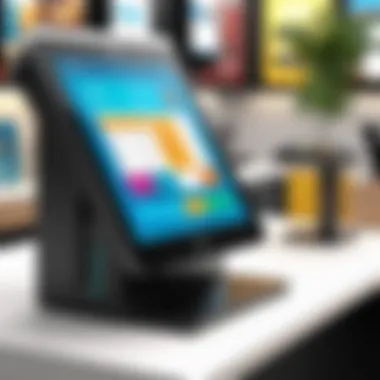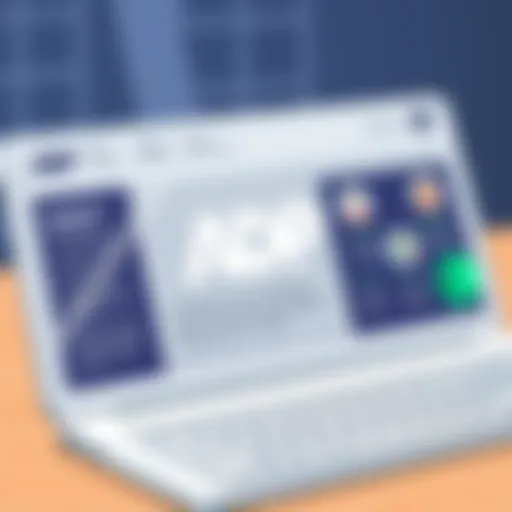Understanding POS Kiosk Software: Features & Benefits


Intro
The world of retail and services is evolving rapidly, with technology playing a pivotal role in enhancing customer experience and operational efficiency. One of the standout innovations in this domain is POS kiosk software. This software provides integrated solutions for point-of-sale systems, allowing businesses to streamline transactions, reduce wait times, and offer a self-service option to customers. This article offers an in-depth exploration of POS kiosk software, delving into its features, benefits, and applications across various industries.
As businesses strive to adapt to the changing landscape, understanding the operational dynamics and key considerations of POS kiosk software becomes crucial. The following sections will guide the reader through essential aspects of this technology, helping inform software selection decisions and operational strategies for a range of industry professionals.
Software Overview
Brief Description of Software
POS kiosk software is designed to facilitate self-service point-of-sale interactions between businesses and their customers. It operates through touchscreen kiosks, allowing customers to browse products, place orders, process payments, and even print receipts without the need for direct assistance from staff.
This solution is particularly beneficial in environments where high volume transactions are typical, such as retail stores, restaurants, and airports. It fosters a more efficient workflow and increases customer satisfaction by reducing queue times.
Key Features and Functionalities
The functionality of POS kiosk software can vary, but key features often include:
- User-friendly Interface: Intuitive design that ensures ease of use for all customers.
- Payment Integration: Supports various payment methods, including credit/debit cards, mobile wallets, and gift cards.
- Inventory Management: Real-time tracking of stock levels, enabling automatic updates and reports.
- Sales Reporting: Comprehensive analytics to track sales performance and customer patterns.
- Customization Options: Ability to tailor the kiosk interface based on brand requirements or seasonal promotions.
These elements collectively contribute to an elevated customer experience while optimizing operational efficiency.
Detailed Comparison
Comparison with Competitors
In a competitive market, several software providers offer POS kiosk solutions. Leading players include Square, NCR, and Toast. Each of these vendors provides unique functionalities, and their offerings may align differently with specific business needs.
- Square focuses on small businesses and offers straightforward integration with existing systems.
- NCR targets larger enterprises providing advanced analytics and customized solutions.
- Toast specializes in the restaurant industry, offering features tailored for food service.
Evaluating these differences can help businesses determine which software aligns best with their particular operational needs.
Pricing Structure
Pricing for POS kiosk software varies widely based on features, support, and deployment options. It is essential to review the pricing strategy in conjunction with the desired functionalities. Common pricing models include:
- Subscription-based Pricing: Monthly fees that allow for ongoing software updates and support.
- One-time Purchase: A full upfront payment providing software for indefinite use, often with additional costs for support.
- Transaction-based Fees: Charges incurred for each transaction processed through the kiosk.
Understanding these structures allows companies to better budget for their POS kiosk solution while maximizing their investment.
"Investing in a robust POS kiosk system can directly impact not only operational efficiency but also customer satisfaction in a significant way."
Overview of POS Kiosk Software
The overview of POS kiosk software lays the foundation for understanding its significance within the retail and service industries. Kiosk software acts as a bridge between technology and customer interaction, enabling businesses to streamline operations and enhance user experience. As more entities embrace automation, the relevance of this software continues to rise.
Definition and Functionality
POS kiosk software refers to a specialized application utilized in self-service kiosks. These kiosks allow customers to perform transactions, access information, and interact with services without needing direct assistance from staff. The fundamental function of this software is to facilitate various tasks, such as product selection, payment processing, and receipt generation.
One critical aspect of POS kiosk software is its user interface design, which needs to be intuitive to ensure ease of use. User-friendly interfaces often result in higher customer satisfaction rates. Furthermore, the software typically integrates features such as payment processing capabilities and inventory management, ensuring a seamless transaction experience.
Historical Context
The evolution of POS kiosk software is rooted in the rise of self-service technologies. Early kiosks, seen in the 1980s, primarily focused on ticketing and information purposes. However, as technology advanced, so did the capabilities of these kiosks. With the introduction of touch screens and later mobile integration, kiosks transitioned into multifunctional devices.
The development of POS software coincided with the growth of e-commerce. Retailers began adopting kiosk technology for greater efficiency and to cater to customer preferences for faster service.
Today, kiosks are present in multiple sectors, including retail, hospitality, and healthcare. They serve as essential tools for businesses aiming to enhance operational efficiency and improve client interactions. Understanding this historical context provides a deeper appreciation of the present landscape of POS kiosk software.
Key Features of POS Kiosk Software
Understanding the key features of POS kiosk software is crucial for any organization looking to enhance its operational capabilities. These features not only define how the software operates but also impact the overall user experience. When businesses invest in POS kiosk software, they should pay attention to specific elements that can bring about significant benefits and affect their decision-making process.
User Interface Design
User interface design is a primary feature that influences customer interaction with kiosks. An effective user interface should be intuitive and easy to navigate. Simplicity in design allows users to complete transactions quickly without confusion. Key considerations include the layout, color scheme, and button size. A clean interface reduces cognitive load, helping users to initiate transactions efficiently.
An appealing design can also enhance brand identity. Companies like ClearCube and NCR have invested heavily in user experience to ensure their kiosks stand out. Providing options for language and accessibility can make a significant difference, catering to a diverse clientele. Functionality combined with a visually appealing design can increase user satisfaction and repeat usage.


Payment Processing Capabilities
Payment processing capabilities are another essential aspect of POS kiosk software. The software must support multiple forms of payment, including credit cards, debit transactions, and mobile payments. Security is key; users must feel confident that their information is protected. This can involve encryption technologies and compliance with industry standards such as PCI DSS.
Moreover, the ability to integrate with various payment processors ensures versatility. For instance, Square and Stripe are examples of processors that offer robust solutions for kiosk environments. Seamless payment processing contributes to a smooth customer experience, reducing queue times and enhancing service speed.
Inventory Management Integration
Integrating inventory management with POS kiosk software is vital for retailers and other businesses. This feature ensures that real-time inventory levels are displayed accurately during customer transactions. Effective integration avoids issues such as overselling and improves stock management. Software like Revel Systems and Toast have functionalities that allow seamless updates between the point of sale and inventory records.
Being able to track inventory in real-time helps businesses make informed decisions about stock levels and ordering. Users benefit from automated alerts for low stock and the ability to analyze sales trends. This integration can provide insights about customer preferences, enabling businesses to optimize their product offerings.
Benefits of Implementing POS Kiosk Software
The integration of POS kiosk software provides several significant advantages across various applications. In this section, we will discuss how these systems enhance the customer experience, improve operational efficiency, and contribute to cost reduction. Each benefit plays a vital role in why organizations should consider implementing this technology.
Enhanced Customer Experience
POS kiosk software offers a streamlined interaction for customers. Users can navigate the interface easily, leading to quicker transactions. For many consumers, this means less wait time, which directly correlates to satisfaction levels. The ability to customize order options at kiosks empowers customers to tailor their purchases without needing direct employee interaction. This not only boosts satisfaction but also encourages repeat visits.
Moreover, many kiosks have user-friendly designs that adapt to different customer needs, accommodating various accessibility requirements. They can provide touchscreen prompts, multi-language support, and visual cues for new users. By reducing reliance on staff for simple transactions, kiosks facilitate a smoother buying process, making routine activities such as checking in or placing an order much easier.
Operational Efficiency
Implementing POS kiosk software can lead to considerable efficiency improvements in business operations. When the workload is shared between staff and kiosks, employees can focus on more complex tasks that require human intervention. For example, staff can engage with customers on the floor, manage inventory, or enhance service quality, all while kiosks handle routine transactions.
Additionally, kiosks enhance data collection through analytics. Businesses can monitor trends in real-time, such as peak hours and popular items. This allows for better stock management and improved marketing strategies. Automated solutions provided by kiosk systems can also streamline processes like payment processing and order tracking, making overall operations more efficient and less prone to human error.
Cost Reduction
Cost benefits are one of the most compelling reasons for adopting POS kiosk software. While the initial investment might appear significant, the long-term savings are noteworthy. With fewer staff needed for transactional roles, labor costs can be significantly reduced. Automation through kiosks can help businesses minimize overtime pay and reduce the reliance on part-time workers.
Moreover, by improving payment processing times and decreasing errors, businesses can experience less financial loss through incorrect transactions. Kiosk solutions can also lower overhead costs associated with spaces traditionally used for waiting or processing customers.
In summary, implementing POS kiosk software can enhance customer experience, boost operational efficiency, and lead to significant cost reductions.
"The shift towards self-service solutions is transforming customer interaction and reducing operational burdens in many industries."
Proactively assessing these benefits can provide a clear justification for investing in this technology.
Applications Across Industries
The use of POS kiosk software transcends beyond mere transactional purposes; its applications are diverse across various industries. Understanding these applications is crucial for stakeholders aiming to leverage this technology for operational improvements and enhanced customer interactions. The flexibility and adaptability of kiosk software allow businesses in varied sectors to address their unique needs, resulting in optimized processes and improved service delivery.
Retail Sector
In the retail sector, POS kiosk software has revolutionized the shopping experience. One of the primary advantages is the ability to manage transactions more efficiently. Customers can complete purchases quickly at kiosks, reducing queue times and increasing customer satisfaction. Moreover, kiosks can streamline inventory management, allowing retailers to update stock levels in real-time. This leads to better stock control and minimizes the risk of overstocking or stockouts.
"Kiosk systems enable retailers to leverage customer data more effectively, providing insights into shopping behaviors and preferences."
These systems can also feature digital displays that promote products and special offers. This enhances marketing efforts directly at the point of sale. As a result, retailers not only improve operational efficiency but also increase sales potential.
Hospitality Industry
In the hospitality industry, POS kiosk software plays a significant role in improving guest experiences. Hotels and restaurants utilize kiosks for check-ins, reservations, and order placements. This often reduces pressure on staff, allowing them to focus on personalized services for guests. For instance, self-service kiosks can enable customers to customize their orders in restaurants, creating a tailored dining experience.
Additionally, kiosks can assist in upselling services or products, such as room upgrades in hotels or special menu items in eateries. This self-service model allows quicker service and increases customer satisfaction, leading to positive reviews and returning customers.
Healthcare Field
The healthcare industry is increasingly adopting POS kiosk software to enhance patient interactions. From check-in processes to managing billing inquiries, kiosks serve a vital role. Patients can use kiosks to complete forms, schedule appointments, and make co-payment transactions, facilitating a smoother patient flow.
Furthermore, these kiosks can collect data for health-related surveys, enhancing the ability of healthcare facilities to adapt to patient needs. Automated kiosks reduce administrative burden on staff, allowing healthcare professionals to dedicate more time to patient care. This transition towards technology ultimately benefits both providers and patients through improved experiences.
Transportation and Travel
The transportation and travel sector utilizes POS kiosk software primarily for ticketing and customer service. Airports and train stations employ kiosks to allow travelers to check-in, print boarding passes, and manage itineraries without needing a service agent. This enhances the efficiency of operations and minimizes wait times.
In addition, transportation services can integrate kiosks to provide real-time information on schedules and fares. Travelers can access relevant data independently, enriching their travel experience. The implementation of such technology demonstrates an effort to modernize service delivery in this vital sector


Overall, the key applications of POS kiosk software highlight its versatility across industries. From improving checkout processes in retail to enhancing patient interactions in healthcare, businesses of all types are harnessing the potential of this technology to optimize operations.
Factors to Consider When Selecting POS Kiosk Software
When choosing POS kiosk software, multiple factors should be considered to ensure the solution meets your business needs effectively. The decision-making process can be layered and complex, as the software selected can impact customer experience and operational efficiency. By understanding what to look for, stakeholders can make informed choices that align with their strategic goals.
Scalability
Scalability is a critical element in selecting POS kiosk software. A solution should accommodate growth without necessitating complete overhauls or additional costs. It is important to select a system that can expand its capacity as your business requirements change. For potential expansion, the software may need to handle increased transaction volumes or additional locations.
When evaluating scalability, consider:
- User load: Can the software support increased user activity during peak times?
- Modular features: Does it allow for the integration of new functionalities easily?
- Performance metrics: How does the system perform under stress?
These aspects ensure that your investment in the software remains relevant over time.
Vendor Support and Reliability
The reliability of vendor support is another crucial factor in this selection process. Efficient software requires ongoing support, especially during initial implementation. Vendors should offer robust customer service, training resources, and timely updates. Poor support can lead to unplanned downtime and lost revenue, which is particularly problematic in customer-facing environments.
When assessing vendor reliability, consider:
- Response time: How quickly does the vendor address issues?
- Expertise and experience: Does the vendor have a track record in the sector?
- Client reviews: What feedback is available about the vendor's support?
Good vendor support can enhance user satisfaction and streamline operations.
Customization Options
The ability to customize the POS kiosk software according to business-specific needs can significantly impact operational success. Standard solutions may not address unique business processes or customer requirements. Hence, looking for software that offers flexibility in design and function is essential.
When evaluating customization, ask:
- User interfaces: Can you modify the interface to enhance usability?
- Feature additions: Can new modules or functionalities be added with ease?
- Integration capabilities: Does it integrate well with existing systems after customization?
Being able to tailor the software ensures it aligns with organizational workflows and improves overall efficiency.
Challenges in Implementing POS Kiosk Software
Implementing POS kiosk software can be a complex process. Recognizing the challenges is essential. Addressing these difficulties early on helps prevent major problems later. With technology evolving rapidly, businesses must navigate numerous issues. This section explores three main challenges: technical compatibility, user training requirements, and security concerns.
Technical Compatibility
Technical compatibility is crucial when adopting POS kiosk software. This software must integrate seamlessly with existing systems. Issues can arise if the software does not mesh well with hardware or current software platforms. Without proper integration, businesses may face inefficiencies. These inefficiencies can include delayed transactions and customer frustrations. Therefore, it is vital to assess the technical specifications of kiosks, back-end systems, and other software components before selecting a solution.
- Evaluate the system architecture of current tools.
- Understand the specifications and requirements of new software.
- Consult with vendors to ensure compatibility.
Ultimately, ensuring a harmonious technical environment lays a strong foundation for successful implementation.
User Training Requirements
Training users to operate POS kiosks effectively cannot be overlooked. Employees need to understand how to use the software for customer assistance. Without proper training, staff may struggle to address customer inquiries or issues. This situation can lead to diminished customer satisfaction.
A structured training program is necessary for successful implementation. Features of such programs include:
- Hands-on training sessions to familiarize staff with software.
- Easy-to-understand manuals and resources.
- Ongoing support to address any concerns post-implementation.
Investing in user training leads to improved operational efficiency and a better customer experience.
Security Concerns
Security is a critical consideration during the implementation of POS kiosk software. The kiosks handle sensitive customer data and transactions. Breaches can have severe consequences for a business's reputation and financial standing. Therefore, it is essential to prioritize security measures.
Key security practices include:
- Regular software updates to patch vulnerabilities.
- Employing encryption methods to protect data.
- Conducting routine security audits to detect and mitigate risks.
Addressing security concerns proactively adds an extra layer of protection for both businesses and consumers.
In summary, while implementing POS kiosk software brings many benefits, challenges must be managed thoughtfully. Effective planning and attention to technical aspects, user training, and security measures lead to successful adoption.


Best Practices for Implementation
Implementing POS kiosk software requires a careful approach to ensure that the system delivers the expected results. Following best practices during implementation can significantly influence the software’s effectiveness and overall user satisfaction. Considerations like planning, execution, and ongoing evaluation are crucial for successful deployment. These practices not only enhance user experience but also promote long-term operational efficiency.
Thorough Needs Assessment
A thorough needs assessment is the foundation of successful POS kiosk software implementation. Understanding the specific requirements of the business and its customers is essential. This involves identifying the primary objectives, such as improving payment processes or enhancing customer service. Key questions to consider include:
- What are the existing pain points in the current system?
- Who are the end-users, and what functionalities do they require?
- How will the software scale with growth?
Gathering insights from all stakeholders helps to align the software's capabilities with real business needs. A well-defined requirements document serves as a guide throughout the implementation process. Engaging with team leads from various departments can highlight insights that might be overlooked otherwise. This collaborative approach aids in creating a clear vision for the kiosk system that meets all operational needs.
Pilot Testing Stage
After assessing needs, a pilot testing stage is crucial before full-scale deployment. Pilot testing allows businesses to evaluate how the software performs in a real-world setting without fully committing to its implementation across the entire organization. During this phase, businesses can:
- Discover any unanticipated issues or bugs.
- Collect user feedback to make necessary adjustments.
- Ensure that the kiosk operates seamlessly with existing systems.
The pilot should be conducted in a controlled environment, ideally a limited area of operation. Monitoring user interaction helps to gather valuable data, which can be used to refine the software or adjust the design. The insights gained during this stage can significantly enhance the software's usability and performance in broader settings.
Continuous Feedback Loop
Finally, establishing a continuous feedback loop is essential for ongoing improvement of the POS kiosk software. After deployment, consistent evaluation helps to identify areas for enhancement. Gathering feedback from users regularly promotes engagement and shows that their opinions are valued. Consider implementing:
- Routine surveys to gather user experiences.
- Analytics tools to track usage patterns and identify bottlenecks.
- Regular meetings with team members to discuss their insights and challenges.
Overall, integrating user feedback into further revisions helps retain user satisfaction and adapt to changing needs. This cyclical process of assessing, adjusting, and evolving keeps the system efficient and relevant in the dynamic landscape of retail and service industries.
"Ongoing evaluation and adaptation is key to successful technology integration."
In summary, adopting best practices such as conducting a thorough needs assessment, performing pilot testing, and maintaining a continuous feedback loop can greatly enhance the effectiveness of POS kiosk software implementation. Businesses should recognize that thorough preparation and flexibility in adjustment pave the way to maximizing the benefits of these modern systems.
Future Trends in POS Kiosk Software
The landscape of POS kiosk software is continually evolving. Understanding future trends is crucial for businesses aiming to maintain a competitive edge. This section explores significant trends affecting the industry. Specifically, it highlights the role of artificial intelligence, the rise of contactless technologies, and the use of data analytics for personalization. These elements not only enhance user experience but also improve operational efficiency.
Integration with AI Technologies
The integration of artificial intelligence (AI) into POS kiosk software is becoming more common. AI provides various capabilities that enhance experience and decision-making. For example, kiosks can utilize AI algorithms to analyze purchasing patterns. This analysis helps in recommending products to customers, making their experience more engaging.
Moreover, intelligent automation features can streamline updates and customer interactions. A self-service kiosk using AI can interpret customer queries and provide instant responses. This capability increases customer satisfaction and reduces wait times. As AI develops, its applications in POS systems will become more sophisticated, further transforming customer interactions.
Rise of Contactless Solutions
Now, with the ongoing push for safety and convenience, contactless solutions are remarkably gaining popularity in POS kiosk software. Contactless payments, especially through mobile wallets like Apple Pay or Google Pay, eliminate the need for physical handling of cards or cash. This trend not only enhances the speed of transactions but also encourages a hygienic shopping environment.
Businesses must adapt to this shift to accommodate consumer preferences that prioritize safety. Contactless solutions can also provide valuable transaction data which businesses can analyze to refine service delivery.
Personalization Through Data Analytics
Data analytics plays a vital role in personalizing the kiosk experience. By analyzing customer data, businesses can tailor offerings based on individual preferences. For example, a fast-food kiosk might suggest meals based on a customer’s previous orders.
Additionally, marketing strategies can be adjusted based on insights gained from data analysis. Understanding customer demographics, peak usage times, and popular products helps businesses bolster their marketing efforts. The use of personalized recommendations improves consumer satisfaction and can drive repeat business.
Data-driven personalization stands as a powerful tool in enhancing customer retention and loyalty.
The End
The conclusion of an article serves as a crucial element, summarizing key insights while also emphasizing the importance of the topic discussed. In this context, the discussion around POS kiosk software culminates in a greater understanding of its implications, benefits, and the considerations for implementation.
POS kiosk software is not merely a trend; it is a critical component for streamlining operations across various sectors. Companies can enhance customer interactions, drive efficiency, and realize cost savings by adopting this technology. The flexibility to tailor these systems to specific business needs underscores their role in future-proofing operations.
Moreover, as kiosks continue to evolve with emerging technologies like AI and data analytics, organizations leveraging these tools will find themselves better positioned in a competitive landscape.
Summary of Key Points
- Functionality: POS kiosk software streamlines transactions and enhances customer service through self-service options.
- Integration: The incorporation of AI and data analytics assures that kiosk software adapts to user needs.
- Customization: Firms can modify these applications to fit unique operational requirements, ensuring maximum impact.
- Cross-Industry Applications: This software is valuable in diverse industries such as retail, hospitality, healthcare, and more.
- Consideration Factors: Businesses must evaluate scalability, support, and security before adopting POS kiosk software.
Final Thoughts on POS Kiosk Software
The landscape of retail and service industries is continually shaped by technological advancements. POS kiosk software stands at the forefront of this transformation, providing tools that enhance customer service and operational efficiency.
Businesses that adopt these kiosks can expect to improve their bottom line while also creating a more engaging experience for their customers. Decisions made regarding POS kiosk software will influence long-term strategies and competitive positioning.
Thus, organizations should consider all facets discussed in this article when selecting and implementing kiosk solutions. This will not only streamline their operations but also provide insights that drive sustained growth and innovation in their respective markets.
"The future is not something we enter. The future is something we create."
Through strategic use of POS kiosk software, businesses have the opportunity to not only participate but also shape the future of service delivery.







